Jitters Simulation

Deterministic Jitter
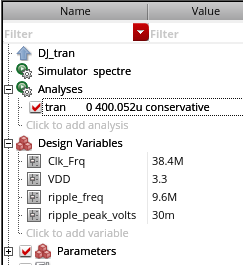

j_Djpp can be calculated by PSD,too
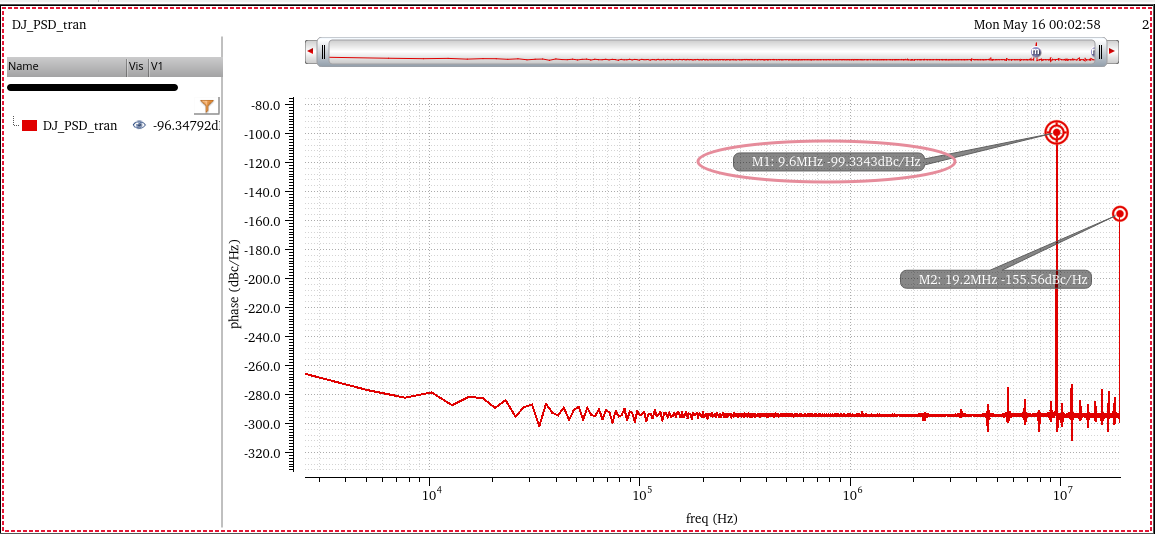
1 | fck = 38.4e6; |
1 | Jpp = |
For DJ, we usually use peak to peak value
BTW, the psd value at half of fundamental frequency (\(f_s/2\)) is misleading and ambiguity, we won't use this value
Random Jitter
RJ can be accurately and efficiently measured using PSS/Pnoise or HB/HBnoise.
Note that the transient noise can also be used to compute RJ;
However, the computation cost is typically very high, and the accuracy is lesser as compared to PSS/Pnoise and HB/HBnoise.
Since RJ follows a Gaussian distribution, it can be fully characterized using its Root-Mean-Squared value (RMS) or the standard deviation value (\(\sigma\))
The Peak-to-Peak value of RJ (\(\text{RJ}_{\text{p-p}}\)) can be calculated under certain observation conditions \[ \text{RJ}_{\text{p-p}}\equiv K \ast \text{RJ}_{\text{RMS}} \] Here, \(K\) is a constant determined by the BER specification of the system given in the following Table
| BER | Crest factor (K) |
|---|---|
| \(10^{-3}\) | 6.18 |
| \(10^{-4}\) | 7.438 |
| \(10^{-5}\) | 8.53 |
| \(10^{-6}\) | 9.507 |
| \(10^{-7}\) | 10.399 |
| \(10^{-8}\) | 11.224 |
| \(10^{-9}\) | 11.996 |
| \(10^{-10}\) | 12.723 |
| \(10^{-11}\) | 13.412 |
| \(10^{-12}\) | 14.069 |
| \(10^{-13}\) | 14.698 |
1 | K = 14.698; |
1 | BER = |

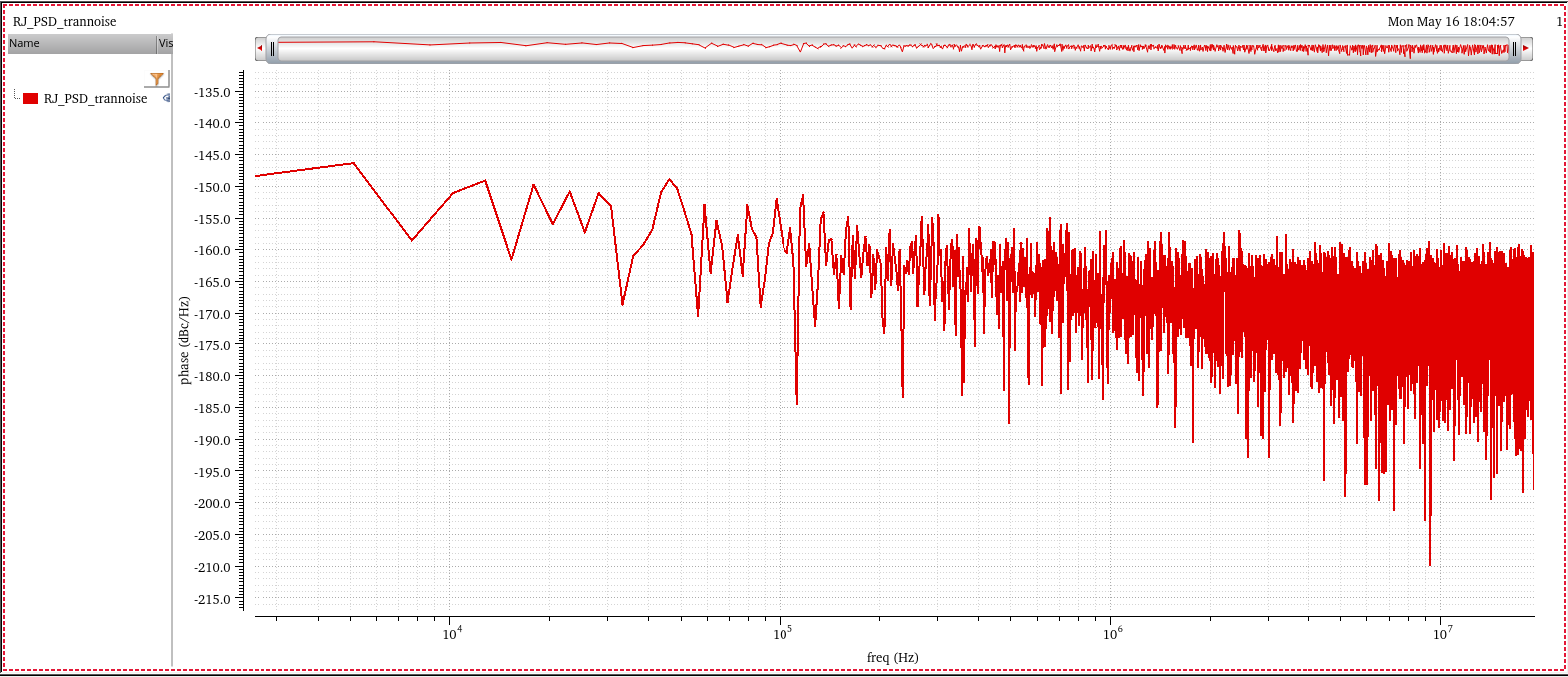
Total Jitter
\[ \text{TJ}_{\text{p-p}}\equiv \text{DJ}_{\text{p-p}} + \text{RJ}_{\text{p-p}}(\text{BER}) \]
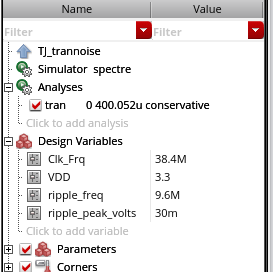
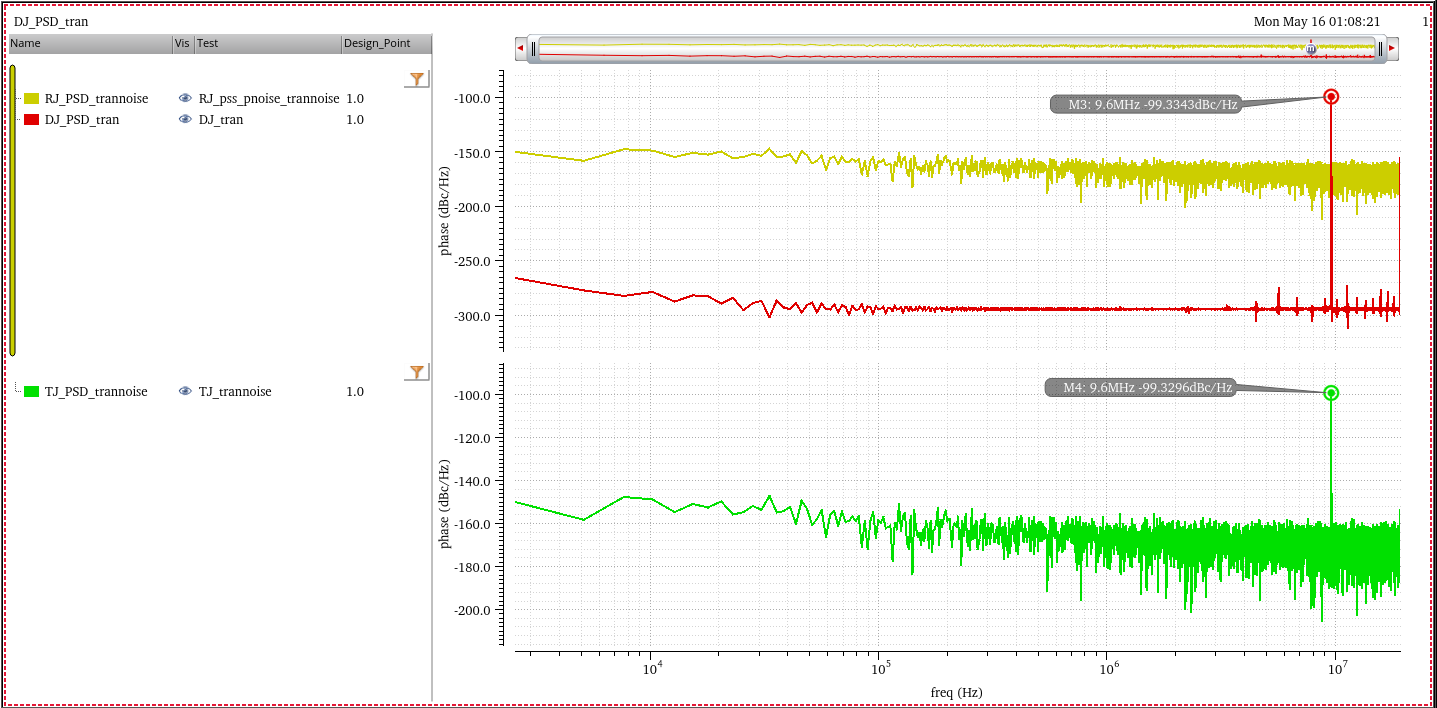
In the psd of TJ, the spur is DJ and floor is RJ
Phase Noise to Jitter
The phase noise is traditionally defined as the ratio of the power of the signal in 1Hz bandwidth at offset \(f\) from the carrier \(P\), divided by the power of the carrier \[ \ell (f) = \frac {S_v'(f_0+f)}{P} \] where \(S_v'\) is is one-sided voltage PSD and \(f \geqslant 0\)
Under narrow angle assumption \[ S_{\varphi}(f)= \frac {S_v'(f_0+f)}{P} \] where \(\forall f\in \left[-\infty +\infty\right]\)
Using the Wiener-Khinchin theorem, it is possible to easily derive the variance of the absolute jitter(\(J_{ee}\))via integration of the corresponding PSD \[ J_{ee,rms}^2 = \int S_{J_{ee}}(f)df \]
And we know the relationship between absolute jitter and excess phase is \[ J_{ee}=\frac {\varphi}{\omega_0} \] Considering that phase noise is normally symmetrical about the zero frequency, multiplied by two is shown as below \[ J_{ee,rms} = \frac{\sqrt{2\int_{0}^{+\infty}\ell(f)df}}{\omega_0} \] where phase noise is in linear units not in logarithmic ones.
Because the unit of phase noise in Spectre-RF is logarithmic unit (dBc), we have to convert the unit before applying the above equation \[ \ell[linear] = 10^{\frac {\ell [dBc/Hz]}{10}} \] The complete equation using the simulation result of Spectre-RF Pnoise is \[ J_{ee,rms} = \frac{\sqrt{2\int_{0}^{+\infty}10^{\frac {\ell [dBc/Hz]}{10}}df}}{\omega_0} \]
The above equation has been verified for sampled pnoise, i.e. Jee and Edge Phase Noise.
- For pnoise-sampled(jitter), Direct Plot Form - Function: Jee:Integration Limits can calculate it conveniently
- But for pnoise-timeaveage, you have to use the below equation to get RMS jitter.
One example, integrate to \(\frac{f_{osc}}{2}\) and \(f_{osc} = 16GHz\)

Of course, it apply to conventional pnoise simulation.
On the other hand, output rms voltage noise, \(V_{out,rms}\) divied by slope should be close to \(J_{ee,rms}\) \[ J_{ee,rms} = \frac {V_{out,rms}}{slope} \]
reference
Article (20500632) Title: How to simulate Random and Deterministic Jitters URL: https://support.cadence.com/apex/ArticleAttachmentPortal?id=a1O3w000009fiXeEAI
Spectre Tech Tips: Measuring Noise in Digital Circuits - Analog/Custom Design - Cadence Blogs - Cadence Community https://community.cadence.com/cadence_blogs_8/b/cic/posts/s . . .